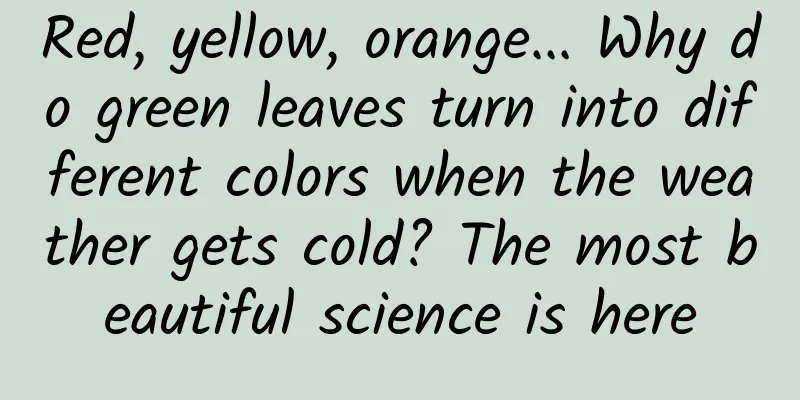Red, yellow, orange... Why do green leaves turn into different colors when the weather gets cold? The most beautiful science is here

|
Expert of this article: Jiang Chenkun, School of Life Sciences, Peking University, PhD Recently, many parts of the country have experienced cooling, rain and snow. With the arrival of the first snow There are many beautiful sights in many places. White snow and colorful leaves match together This picture↓ If snow is the symbol of winter Then the yellow ginkgo and the fiery red maple leaves There are fallen leaves all over the ground It must be autumn While enjoying this beautiful scenery, I can't help but feel curious Why are plant leaves green in spring and summer? When the weather gets cold, the color changes. Then it fell again? Come and understand the mystery behind this Why are the leaves of most plants green? Unlike most animals, plants that do not "move" cannot quickly change their spatial position to find food. In order to obtain energy for life activities such as growth and development, plants need to use light energy from the sun. This process of converting light energy into energy that plants can use is called photosynthesis. Capturing light energy is the first step in photosynthesis. The "tools" that plants use to capture light energy are pigments that absorb visible light. These pigments are mainly found in the leaves of plants and can be divided into two categories: A yellow to orange carotenoid found in smaller amounts. Chlorophyll, which is present in high content, is the "protagonist" in light capture during photosynthesis. Chlorophyll mainly absorbs blue-violet light and red-orange light, but not green light. The green light in sunlight is either reflected by the leaves or penetrates the leaves, so most leaves appear green. Do leaves also "age"? “Stop the car and sit to enjoy the maple forest in the evening” "The mountains are all red, and the forests are all dyed red" Autumn is the most colorful season of the year in northern my country. Unlike the blooming spring, the shady summer and the snowy winter, the autumn in the north has the richest colors because the green leaves gradually change color in autumn. The color change process of plants is fleeting. When the north wind blows, the color-changing leaves will soon flutter in the wind and finally fall back to their roots. Is the discoloration and falling of leaves similar to the graying and loss of hair in humans? That’s right, individual organisms experience aging, and leaves also go through the aging process. Under the induction of specific environmental factors, such as low temperatures and shorter daylight hours in autumn, the leaves of some plants will undergo self-regulation and age, accompanied by a series of physiological and biochemical changes. Its direct manifestation is the change of color and the shedding of leaves. "Aging and losing color" is the fate that leaves have to go through. After the color of the plant leaves changes, they will eventually fall off the plant body, completing its life cycle. Green leaves change color, why are the colors different? The change of leaf color is related to the change of the type and content of pigments. During the aging process of leaves, some pigments gradually decrease, and some new pigments may be synthesized, so the leaves will change from green to other colors. During the aging process of leaves, the light-harvesting chlorophyll content will decrease, so the green color of the leaves will gradually fade; carotenoids will also be lost in this process, but some carotenoids will still remain in the leaves, which makes some leaves appear yellow. In some cases, such as some plants like Populus tomentosa, the chlorophyll is not completely lost before leaf fall, and the leaves will appear light green or yellow-green. The reason why the leaves of some plants turn red before they fall is that the leaves synthesize a type of red-purple pigment called anthocyanin (also known as anthocyanin). If there is still chlorophyll in the leaves containing anthocyanin, the leaves will appear brown; if the leaves contain anthocyanin and carotenoids, they will appear orange. Some studies have suggested that anthocyanins can act as antioxidants to help plants resist adversity, or may help plants attract birds to spread fruits and seeds, which is beneficial for reproduction. Other studies have suggested that anthocyanins have the function of "sunscreen", protecting leaves from sunlight damage after chlorophyll degradation. In some plants, the color changes of leaves are synchronized, such as some plants of the genus Vaccinium in the Ericaceae family; in other plants, the color changes of leaves are uneven in different individuals, different positions, and even on a single leaf, such as Ginkgo and Acer truncatum. Which plants have leaves that turn red? Representative "red-leaf plants" in China include the Cotinus coggygria of the Anacardiaceae family, the Acer truncatum of the Aceraceae family, the Sapium sebiferum of the Euphorbiaceae family, the Parthenocissus quinquefolia of the Vitaceae family, and the Liquidambar formosana of the Altingiaceae family. Why do discolored leaves fall off? Under normal circumstances, plants will eliminate some weak organs by shedding leaves, which is a means of self-regulation for plants. In certain circumstances, such as drought, rain, and malnutrition, leaves will also fall prematurely. Shedding leaves in autumn can help plants minimize the loss of energy and water in winter. Before falling off, in addition to chlorophyll, proteins and other substances will also be degraded. These degraded substances are still "very nutritious" and will be reabsorbed by the plant body. Subsequently, some cells at the base of the petiole will undergo cell wall degradation, causing the cells to separate. Under the action of external force, the leaves will fall off. Do all perennials lose their leaves? Yes. The perennial plants mentioned above that have seasonal leaf senescence and shedding are called deciduous plants. Most of them grow in temperate and cold regions, such as Larix gmelinii of the Pinaceae family and Platanaceae sycamore of the Platanaceae family. Another type of plant is called evergreen plants. Unlike deciduous plants, their leaf senescence process is asynchronous, with only some leaves aging and falling off in a period of time, such as pine plants that do not wither through the winter and most perennial plants in southern China. There is also a special type of plants that grow in tropical or subtropical areas, but will complete leaf shedding and new leaf growth in a very short period of time. They are called semi-deciduous or semi-evergreen plants, such as the banyan tree of the genus Ficus in the Moraceae family. Although deciduous plants are lonely in the cold winter don’t worry They will be revived in the spring of the following year. Dressed in green “Winter is here, can spring be far behind?” The pictures in this article with the "Science Popularization China" watermark are all from the copyright gallery. The pictures are not authorized for reprinting. |
<<: Why do you fry two dough sticks together? Is it because of love? "Singles" please avoid...
>>: What kind of magic is used to turn "silicon" into "solar cell"?
Recommend
Apple, Microsoft, and Google: The Harmony of the Technology Industry
[[137102]] Microsoft Build, Google I/O, and Apple...
The secret to increasing fans and realizing monetization through refined operations!
Although traffic and fans are very important, wit...
Li Pi's "The Fifth Session of Douyin Short Video Sales Training Camp" Listen and do as you are told to ensure orders
Introduction to the training course content: No re...
Counterpoint: Global cellular IoT module shipments fell 2% in Q3 2023
According to the latest data from Counterpoint, g...
From Li Jiaqi's IP: The "hidden rules" of cross-platform account operations
In the Internet age, information flows faster and...
Foreign Academician Liu Ke: There are six misunderstandings about carbon neutrality. Electric vehicles are actually increasing carbon emissions.
Due to concerns about global carbon emissions, ma...
NetEase’s marketing methodology for screen-sweeping!
To swipe the screen once may be luck, but to swip...
360 and Beijing Internet Security officially launched China's first Internet security cinema
China's first cybersecurity cinema goes onlin...
Embrace HTML5, Flash is gone
[[151388]] When HTML5 came out, the prediction of...
Why is barrage so hated?
What are the reasons why barrage is hated? There ...
Simple homemade mooncake recipe, easy to operate, nutritious and delicious!
【Halal Date Paste Mooncake】 raw material: Crust: ...
Unpopular and side business projects that can make huge profits. What are some good unpopular business projects?
What is the most valuable thing on the Internet? ...
How can you make a product go viral even with minimal advertising?
Why is it that even though some products are rare...
Can sleep-aiding aromatherapy really cure insomnia? Don’t believe it anymore because…
“Sleep-aiding aromatherapy can cure insomnia.” Th...
A complete collection of classic advertising slogans from all industries
A creative slogan or advertising copy can often t...









